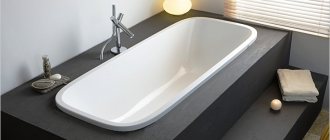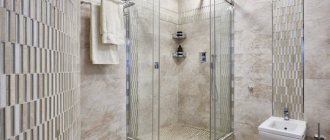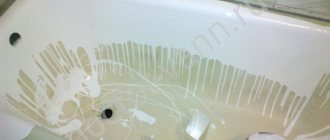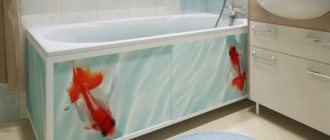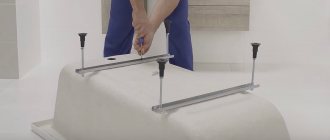It often happens that you really want to update the plumbing in the bathroom, but finances do not allow you to spend money on a good cast-iron or thick-walled acrylic font, or maybe even a quarry one . In this case, usually, steel bathtubs or inexpensive thin-walled acrylic ones are purchased.
Everything would be fine, but metal products have 2 very unpleasant drawbacks : high thermal conductivity (water cools quickly) and poor sound insulation (very loud sound from a jet of water).
But don’t be upset, during the installation process it’s quite easy to get rid of these disadvantages, there are many ways to insulate and soundproof a steel bathtub , but today we will focus on the simplest and most affordable - heat and sound insulation using polyurethane foam (polyurethane sealant).
In cheap acrylic hot tubs, these shortcomings are expressed, of course, to a much lesser extent, but the insulation of such products will not be superfluous.
Advantages and disadvantages of steel containers
: expensive and heavy, replaced steel and. A steel alloy bathtub is the best option for replacing an old bathtub. However, many people still do not trust steel bathtubs. This attitude towards this plumbing equipment has developed due to the fact that the sound insulation of a metal bathtub made of a steel alloy is low.
But this is a minimal drawback of a steel bathtub, which can be easily and simply eliminated. A steel bathtub has many advantages, which are a strong argument in favor of choosing steel structures.
The advantages of steel bathtubs are:
- Low cost of equipment compared to acrylic and cast iron bathtubs,
- Durable coating of enameled surfaces,
- Rapid heating of metal
- structural stability,
- Easy to deliver, move, install and dismantle,
- Possibility of different fastenings,
- Modern varied design and size.
Some people consider the following to be disadvantages:
- Low sound insulation of a steel bathtub,
- Rapid heat loss.
Inserting a bathtub into a niche
Insert into a niche
In small-sized apartments, a situation very often arises when a bathtub is placed with great difficulty in the space allocated for it, which, on the one hand, significantly complicates its installation, and on the other hand, provides the possibility of rigid and reliable fixation in a bathroom niche.
To insert and rigidly fasten the bathtub, you will need to prepare grooves in the wall on each of its sides according to the thickness of the edge of the product (for these purposes, you can use a hammer drill or grinder). The edges or flaps of the bathtub should be inserted into the grooves prepared with their help with a slight “tightness”, which guarantees maximum rigidity of the fastening due to the complete absence of play.
If the legs supplied in the kit are not sufficiently rigid, you can further strengthen the fastening of the bathtub by using special transverse profiles that serve as supports for its flaps.
Sound insulation and insulation of a steel bathtub
However, many do not think about the fact that there are many possibilities and ways to easily, simply and quickly eliminate these shortcomings with your own hands when installing a container. A number of measures to eliminate noise and heat loss can be applied in advance of installation. And this will make the steel bathtub quite competitive, not inferior in its performance data to other structures of this type made of acrylic and cast iron.
Soundproofing a steel bathtub with your own hands is a simple manipulation, inexpensive, accessible and does not require special skills.
When purchasing imported equipment of this type, many paid attention to the presence of rubber or rubberized pieces of special material glued to the bottom of the bathtub. It is this material that is able to retain heat and absorb noise and splashes of water.
The process that makes the insulation of a steel bathtub complete is based on this principle of sound absorption.
So, there are several simple ways to eliminate hum and retain heat.
Vibroizol
Application of grout
When deciding how to seal the joint between the bathtub and the tiles, you should first pay attention to the grout. This is a durable, waterproof material. Its advantage is the large number of shades. This allows you to perfectly match the color of the seam to the existing interior elements.
The most popular, despite everything, remains white grout. The bathtub most often has this color. Grout is used when the gap that needs to be filled is small. This substance does not require special skills from the master. Everything happens simply and quickly. The seam will be moisture resistant and will retain its original shade for a long time.
The grout is applied with a spatula. Then the layer is treated with a special agent to prevent the accumulation of dirt on the material. However, if the gap is quite large, this method will not work.
Vibroizol
In shops and supermarkets, in markets specializing in the sale of auto parts. This is where you can find the Vibroizol material. This is a specially developed material with a unique composition, which is intended for use in the automotive industry. With its help, many car enthusiasts restore the sound insulation of their car. Vibroizol is based on bitumen and a rubberized base. One side of this material has a strong adhesive composition.
Note!
This composition adheres tightly to any smooth surface at any air temperature.
If Vibroizol perfectly eliminates noise in the car interior, then it will perfectly cope with its task in the bathroom - it will eliminate unnecessary sounds. To do this, the outer part of the bathroom is covered with this unique material. It is possible to treat with Vibroizol only the areas where water falls into the container from the tap and the area where the human body comes into contact with the bottom and some of the side walls of the bathroom. This will reduce the hum and noise of the water jet and help retain the heat of the container walls.
Application of sealant
If the gap between the plumbing fixtures and the wall is small, you can use acrylic or silicone bathroom sealant. This is one of the most modern and reliable methods. There are colored sealants, but the white varieties are most often used.
Acrylic sealant is used less frequently. Silicone varieties are more suitable for the bathroom. They include special components. This prevents the formation of mold, mildew and microorganisms on the seams. Sanitary white sealant is ideal for the purposes presented.
To carry out the work you will need a special sealant gun. But it can be bought at any hardware store for a fairly low cost. The gun can be used for economic purposes in the future. Even a master without experience can perform all the steps well.
Polyurethane foam
The question often arises - how to thoroughly insulate an iron bathtub. The answer is quite simple - you need to use ordinary construction foam. Exactly the foam that is used to seal windows and doors.
The bathtub container is turned over and a layer of polyurethane foam is slowly applied. The foam is applied to a previously degreased surface. To do this, treat the outer part of the bathroom with an alcohol-containing composition. For convenience, the bathtub is turned over from its legs onto the sides of the container, placing it on a soft surface to prevent accidental scratches. The polyurethane foam is applied evenly, in a continuous layer, without gaps. To prevent the foam from draining, the layer is applied slowly, and the bath is turned from one side to the other as it is covered with foam. But only after the foam has dried.
To enhance the sound absorption effect, you can additionally use polyethylene film. It is best to use polyethylene, which is intended for forming greenhouses. It is dense, elastic, inexpensive. After applying the foam, a previously prepared piece of film is applied to its surface. He presses his hands against the foam, forming a “crust” on the area, similar to a shell. This will be additional insulation.
Noise insulation with polyurethane foam
When treating the outside of the bathroom with polyurethane foam, you should follow some rules:
- Foam should be used indoors.
- Foam for use in summer is more practical, as it is resistant to high temperatures and swells better.
- In order for the layer to be uniform, without sharp bumps, gaps and stacks, it is necessary to use a special nozzle for applying foam. Usually a special “ ” is used.
- In order for the foam output to be as large as possible and at the same time economical, you should heat the foam container under running hot water and shake it thoroughly.
- The place where the siphon is installed and the part adjacent to it should not be covered with a layer of foam. Since this place must be accessible when changing the siphon.
- The overflow area should be left free.
- It is imperative to pay attention to the terms of use of polyurethane foam, since this product loses its performance properties after the expiration date.
There are different ways to soundproof
DIY recipes and methods
To prepare a bubble bath, it is most convenient to use a ready-made cosmetic product. To get a fluffy head of foam, a small amount of liquid (10-20 ml) is enough. It is best to do this at the moment when water is drawn into the bath. This will ensure that airy foam is obtained without additional human effort.
To make foam at home, you need to take the ingredients that every housewife has in stock - liquid or solid soap, glycerin, extracts of various oils (coniferous, fruit, floral, etc.).
From solid soap
To make foam, you first need to prepare a soap solution - grate a bar of any solid soap and add water in a ratio of 1:8. You also need to know what you can use to replace a bar of toilet soap. To do this, use a liquid product. The main thing is that it is without a pronounced odor. This will help not to overpower the aroma of the oils.
You need to add a small amount (50-100 g) of glycerin or coconut oil to the finished product. They ensure bubble stability and prevent foam settling. In addition, the composition can include extracts of herbal plants, milk, chocolate, honey. To add scent, add 10-12 drops of essential oil - apricot, grape seeds, wheat germ, pumpkin, almond, etc. - to the mixture.
From shampoo with glycerin
To prepare foam, you need to mix shampoo and glycerin in equal proportions. It is best to take 100 ml of each component. Add 1 glass of water and a few drops of any essential oil. The composition must be mixed carefully to prevent the formation of foam. The finished product must be stored in a glass container. Add to water if necessary to obtain air mass.
Removing cellulite
In the fight against cellulite, you can use foam with the addition of lemon, grapefruit and orange oils (1000 ml of water, 100 g of liquid soap, 100 g of glycerin, 5-7 drops of essential oils). This remedy has a tonic and activating effect. This effect helps fight cellulite.
Egg white based
Foam based on egg whites has good stability - the bubbles hold their shape and create a massive cap above the water. To improve the effect and achieve a healing effect on the epidermis, you need to add a little liquid honey, as well as a few (5-8) drops of essential oil.
Required ingredients:
- 100 ml of liquid soap without fragrances;
- 1 egg white;
- 1-1.5 tbsp. l. fresh liquid honey;
- 5-6 drops of your favorite oil.
If the skin is dry, it is advisable to include 1-2 tsp in the composition. olive, flaxseed, coconut or almond vegetable oil. This will help ensure good nutrition of the epidermis and soften the skin.
Egg white foam should be stored in the refrigerator for no more than 7 days. After this period, the product cannot be used.
Pep
A bath with citrus foam invigorates, improves mood and improves tone. To do this, mix 0.5 cups of glycerin and liquid soap. Add lemon, mint and petitgrain oils. The optimal amount is 5-7 drops. This will help achieve a pleasant aroma, but avoid over-saturating the air with odors.
To improve your well-being during a viral infection, you should take a steam bath, after adding mint and eucalyptus extract to the water. Using vanilla and jasmine, as well as ylang-ylang, will help lift your mood. When mixing, avoid the formation of foam.
Baby foam
You can make foam for your baby with your own hands. However, you only need to use baby shampoo for this to avoid the occurrence of adverse reactions, such as individual intolerance to individual components. To do this, you need to mix 50 g of special shampoo for babies, 50 g of glycerin, 100 g of water. Additionally, you can add 2-3 drops of essential oil.
With just a few minutes spent preparing the foam, baby's bath time will be a fun adventure. He will love hygiene procedures and will not be afraid of water.
Other ways
There are some other ways to insulate a steel bathtub. Often a steel bathtub is installed on a pedestal and then covered with slabs or bricks. Then lay tiles on top. This method of installing a bathtub helps improve sound insulation, but also provides the opportunity to fully retain heat. But if you cover the bathtub with an additional layer from the inside of the wall, you will be able to correct the situation.
There is a method of increasing thermal insulation using technical cork. This method is more expensive, but the most environmentally friendly.
Note!
With this method, the fire safety and moisture resistance of the structure are high.
The technical plug is applied according to the instructions.
See inaccuracies, incomplete or incorrect information? Do you know how to make an article better?
Would you like to suggest photos on the topic for publication?
Please help us make the site better!
Leave a message and your contacts in the comments - we will contact you and together we will make the publication better!
It often happens that you really want to update the plumbing in the bathroom, but finances do not allow you to spend money on a good cast-iron or thick-walled acrylic font, or maybe even. In this case, usually, steel bathtubs or inexpensive thin-walled acrylic ones are purchased.
Everything would be fine, but metal products have two very unpleasant problems: high thermal conductivity (water cools quickly) and poor sound insulation (very loud sound from a jet of water).
But don’t be upset, during the installation process it’s quite easy to get rid of these disadvantages, there are many ways to insulate and soundproof a steel bathtub, but today we will focus on the simplest and most affordable - heat and sound insulation using polyurethane foam (polyurethane sealant).
In cheap acrylic hot tubs, these shortcomings are expressed, of course, to a much lesser extent, but the insulation of such products will not be superfluous.
Application of skirting boards
Sometimes it is impossible to close the seam between the bathtub and the tiles using only sealant or foam. This is due to the large distance from the bathtub to the tiled surface. In this case, you should resort to the help of special skirting boards. They are often supplied complete with tiles.
If the gap is more than 4 cm, you can use ceramic, plastic, polyurethane borders, as well as self-adhesive tapes. Before starting work, work surfaces are prepared accordingly.
After taking measurements, the required length of the plinth is cut. An adhesive is applied to the inner surface of the product. You can use “liquid nails”. After this you need to wait a few minutes. Then the plinth is installed in the place allocated for it and pressed firmly. Particular attention is paid to the corners.
After fixing the plinth, its upper and lower edges are treated with sanitary silicone sealant.
Material selection
Is it possible to use polyurethane foam in the bathroom? Yes, but the main condition when choosing it is the presence of moisture resistance
.
After all, condensation from hot water will gradually accumulate on surfaces, and if the selected sealant is not resistant to moisture, it will quickly shrink and become unusable.
You also shouldn’t skimp on the manufacturer, because you only need 2 cylinders to operate.
If you look for a cheaper sealant, you will only win 100-200 rubles, but there can be many problems with low-quality foam. Up to the need for its complete replacement. It will also be much more convenient to use it with a special pistol.
What tools are needed?
To perform the work efficiently and correctly, you will need the following list of tools and materials:
- 2 cylinders of polyurethane foam;
- degreaser;
- spray bottle with water (to wet the surface of the bowl);
- knife (for cutting off excess);
- foam gun;
- respirator (foam vapors are volatile, it is better to protect the respiratory tract).
Instructions on how to properly foam a steel hot tub?
Typically, this method is used to soundproof steel bowls, but it can also be used for acrylic bathtubs.
Be sure to read articles about other methods and soundproofing of bathtubs.
STEP 1.
Place the bathtub upside down on the floor. Don’t forget to first place pieces of cardboard underneath it so as not to scratch the enamel surface.
STEP 2.
Be sure to thoroughly wipe off dust from the surface on which you are going to apply the foam. Then you need to degrease it; for this you can use a universal degreaser, alcohol or dishwashing detergent.
STEP 3.
It is better to prepare the container before use.
It needs to be shaken well and heated a little by placing it under running warm water for 5 minutes. It would be enough. Under no circumstances should you heat the cylinder in a kettle or boiler, as many resources advise.
Due to a significant increase in pressure, it can explode. STEP 4.
Spray the bath generously with water using a spray bottle. This way the foam will stick to the surface much better. If the bowl dries out during application, repeat the procedure.
STEP 5.
Place the can on the gun and get to work.
It is better to apply the foam in dense layers using a snake. Start with flat surfaces and gradually work your way up. There are no special recommendations for the sequence of surface coating. It is important not to leave any gaps. Sometimes the drain needs to be replaced, so it's best to leave a little space around the hole.
STEP 6.
Now you need to leave the font until completely dry for 5-6 hours. After the foam has completely dried, cut off any excess foam where the legs are attached using a knife.
Video instruction
In addition to the undoubted advantages of metal bathtubs - light weight, low price and durability - they also have disadvantages that can cause some inconvenience to their owners. So in metal bathtubs the water cools down quite quickly, and when they are filled with water they make a loud, unpleasant sound. But do not be upset about this, since these problems can be resolved.
Cover the outer surface of the bath with a layer of insulation, which will simultaneously provide sound insulation. There are several coating options, and one of them is using vibration insulation, which is freely sold in almost every automobile store. Having an adhesive surface, it easily adheres to metal surfaces at room temperature.
As practice shows, when using vibroisol, there is no need to cover the entire outer surface of the bathtub with it. It is enough to apply a small amount of the substance to surfaces exposed to the water jet and to the sides. When the vibroizol completely hardens, the unpleasant hum will disappear, and the hot water will retain its heat longer.
Vibroizol has an excellent substitute - ordinary polyurethane foam. Turn the bathtub upside down, for better adhesion, moisten the surface with water and begin to carefully, without haste, apply foam over the entire outer surface, except for the places where the drain holes are located.
It is recommended to lay polyethylene on top of the foam and carefully straighten it. This may take you up to four large containers of polyurethane foam. After the foam hardens, a metal bath retains heat even better than a cast iron bath.
You can also use foam plastic to insulate the bathtub. To do this, you will need the required amount of foam, which is commercially available, and the appropriate adhesive composition.
Try to purchase glue that is resistant to high temperatures. And then everything is extremely simple: apply glue and then adjust the pieces of foam to each other. Remember that a five-centimeter thick layer of insulation can provide normal thermal insulation and sound absorption.
The modern world of plumbing offers its customers only 3 types of bathtubs: cast iron, steel and acrylic. Cast iron implies reliability, durability, but at the same time heavy weight, high cost and complexity of installation. A steel bathtub, in turn, boasts light weight, ease of installation, relatively low cost and a large selection of sizes. In addition to a large number of advantages, these baths also have their disadvantages: poor heat retention and low sound insulation. As for acrylic bathtubs, they are practically silent when filling with water, have low thermal conductivity, and their surface is completely non-slippery. Disadvantages: they are very fragile and scratch easily.
However, owners of steel and acrylic bathtubs can eliminate their shortcomings. To do this, you need to know how to foam a bath. For this you will need:
High quality polyurethane foam;
Solvent;
Extreme care and accuracy.
To foam a steel bathtub, you need to turn it over and place it on a flat surface. Position it so that access is provided from either side, since you will need to walk around the bathtub when working with foam.
First you need to wipe the outside of the bathtub with solvent. After this, you need to move on to the foaming itself. You will need about 3 packs of foam. The thickness of the foam layer should be the same around the entire perimeter. The optimal layer width is 2-3 cm. It is best to apply foam in a circle, carefully adhering the layers to each other, avoiding gaps.
It will take about an hour for the foam to set, and 12 hours should pass for it to completely harden. After the foam has become absolutely hard, you can install the overflow drain and siphon. If there is excess foam where they enter the bath, they must be removed.
Many people are interested in the question: how to foam an acrylic bathtub and why do it? And indeed, it is warm and silent. There is one “but” here: the acrylic bathtub is not entirely stable. A strong push can move it, which will not happen, for example, with a cast-iron bathtub.
Therefore, for greater stability, it is customary to make a special substrate under the bottom of the bathtub. Bricks, rubber, boards and much more can be used for this, but why all this complexity if you can use polyurethane foam?! Plastic bottles filled with water can be placed between the floor and the bottom of the bath to serve as a base. They need to be foamed, lifting the layers up to the bottom of the bath. The bathtub must first be filled with water so that the foam cannot rise. After the entire process is completed, let the foam harden. Now you can take a shower in peace and not worry about the bathtub moving out of place.
Knowing how to foam a steel acrylic bathtub, you can independently ensure complete comfort during water procedures for the whole family.
conclusions
We looked at a very effective way to soundproof a bathtub. The main advantage of this method is its simplicity and low implementation price. We hope it will help improve your comfort when using plumbing fixtures.
The most popular products on the plumbing market are steel bathtubs. In some ways, they can be called budget class, since their price is relatively low.
However, with proper handling, such products can boast a very long service life.
At the same time, the owners of such bathtubs note a couple of serious shortcomings.
- Firstly, the water in them cools much faster than in their cast iron counterparts;
- and secondly, a very loud sound is made by the stream of water gathering, which can be heard not only in neighboring rooms, but also in apartments.
And these shortcomings can negate the main advantage of such baths, namely, low cost.
However, this is not such a problem, because both the noise and the rapid cooling of the water can be forgotten once and for all if the steel bath is properly insulated. This will be discussed in this article.
Flexible tape
The gap between the bathtub and the tiles can be closed using flexible self-adhesive tape. This is a simple option, suitable even with a fairly large gap. Such products are quite flexible. Tapes are produced in various sizes. This allows you to choose the best product for your bath.
The back surface of such tapes already has a special adhesive layer. Thanks to this, installation is very quick and simple. Such tapes have a bend in the center. This adds comfort during installation.
It is necessary to thoroughly clean and dry the base of the wall and the side of the bathtub. The protective layer is removed from the back side of the tape. Now it can be glued to the surface. To ensure good adhesion, the tape can be slightly heated with a hairdryer. The product is applied to the gap and pressed.
This is a sealed and aesthetic joint. However, its strength is inferior to solid baseboards. Also, the service life of the strip border will be shorter.
About steel baths
Despite the fact that cast iron is considered the traditional material for making bathtubs, metal and plastic products are quite common these days. And if in this case most buyers do not trust plastic, then people willingly purchase metal bathtubs.
After all, even over cast iron analogues they have several advantages, among which it should be noted:
- Low cost.
- Light weight.
- Durability and shock resistance.
- The metal heats up very quickly. It is enough to open hot water for a few seconds, and such a bath becomes warm.
Taking into account all the advantages, it can be noted that steel bathtubs are worthy competitors to traditional cast iron ones, but require minor modifications, namely insulation.
Preparing for insulation
How to insulate a bathtub and how to insulate a bathtub? These two questions concern many home craftsmen, and the answers to them are much simpler than they might seem at first glance.
For insulation, it is best to use polyurethane foam. This material is very easy to install, and you can carry out the thermal insulation process with your own hands without any difficulties or problems. Polyurethane foam is a universal insulating material that is used as insulation for windows and doors.
As the main or additional thermal insulation material, floors, roofing, it is also used to insulate loggias.
Most often, polyurethane foam is used to seal the joints and cracks between the main slabs. However, this heat insulator is often sprayed directly onto the insulated surface in a continuous layer.
To insulate the bathtub, you will need ordinary polyurethane foam, which is sold in cans and does not require the use of any special devices.
Advice! Insulation should be done before the initial installation of the bathtub, because dismantling an installed and tiled product is a rather difficult task.
Before work, you should make the necessary preparations:
- The product must be assembled and fully prepared for installation
. Install the drain siphon and secure the legs. - Clean the surface from dirt and dust
. - Before applying polyurethane foam, the surface should be well moistened
. We wet the cloth generously with water, washing away dust and dirt from the bathtub. - Next, you should prepare polyurethane foam for the insulation process
. To do this, shake the container thoroughly. If possible, you should warm it up further by placing it under running hot water. This will maximize the foam output from the can, saving you money and time.
Advice! If you subsequently plan to sew and cover with tiles, then you need to install a UD guide profile on the front side of the bathtub.
We insulate the bathtub
The instructions for thermal insulation involve several stages:
We should also talk about wall insulation. Here there may be slight difficulties with applying insulation. So, the foam can subside and flow down in large chunks. In principle, if you carry out the entire process carefully and slowly, without applying foam with a strong stream, then you will not have any problems.
But if you are not sure that you can handle this process, then it is better to wait a little until the foam applied to the bottom dries completely (this will take no more than half an hour).
After this, simply turn the bathtub on its side and continue working in the same way.
How I became a victim of an acrylic bathtub: personal experience
“When I bought a bathtub last year, I was sure that I was seeing the light from the tunnel called “repair,” but how cruelly I was mistaken - it was not the light of the finale, but of the next renovation, which would be caused by that same bathtub. But first things first.
As a specialist in the field of renovation, I prepared for the issue of transforming my new apartment and took into account all the risks: a construction team of professionals carried out all the work in accordance with the standards and used high-quality materials.
There are no complaints about the builders, just as there are no questions about the quality of the materials: six months later my parquet was flooded with boiling water from the apartment above, but not a single board was damaged and the floors did not go “in waves” - the parquet was of high quality, it was installed by professionals.
But one unpleasant surprise awaited me, which I bought myself and brought to the apartment - an acrylic bathtub.
In my old apartment I have a good steel bathtub, but in the new one I decided to install an acrylic one, because it is lighter and more comfortable in it - it is warm, while a metal bathtub is cold and the water in it cools down quickly. I was also convinced of the right choice by the manufacturer, who guaranteed a service life of 30 years.
And I made this mistake.
The bath cost me a small amount - a little over six thousand rubles (they gave me a good discount). The builders carried out the installation, sealed the gaps in the bathtub and porcelain tiles - the renovation of the entire bathroom was completed, which made me happy.
Knowing that acrylic is a special material, I looked for special alkali-free products to clean the bathtub, so as not to spoil the coating or burn it with chemicals during cleaning. But after six months, the products stopped working: it became more difficult to clean the bathtub. Don’t think about it, I didn’t walk in the bathtub in my shoes and didn’t cook soup in it, but dirty stains appeared, and it became more and more difficult to remove them. In this bath I only took a shower and occasionally washed the cat.
As 8 months passed since the bathtub was installed, I began to notice other changes: the bottom of the bathtub sagged a little and persistent gray spots appeared. A year later, the bottom of the bathtub sagged even more; water collected there, which could not overcome the laws of physics and rise to the drain. The stains became more contrasting and I stopped inviting guests because they might notice the dirty bathtub and think I was untidy. I desperately scrubbed away the gray stains, but in vain.
Features of steel
Steel is a strong, durable and corrosion-resistant alloy that is actively used for the manufacture of plumbing equipment. Steel bathtubs belong to the lowest price category, are distinguished by a variety of models, colors and ease of installation, which is why they are deservedly popular among buyers. But during operation, you will notice that the water in products made from this material cools down faster, and when filled, it is noisier than cast iron bathtubs.
These features are associated with 2 characteristics of steel:
- High thermal conductivity. When hot water is drawn into a steel bath, the walls of the bowl quickly heat up, but also quickly remove the water, releasing heat to the environment. As a result, the water quickly cools down, which reduces the comfort of performing hygiene procedures. If you don't insulate your hot tub, you'll either have to get out of the bath or constantly add hot water, which causes your utility bills to skyrocket.
- High resonating ability. The walls of steel bathtubs are 2-3 times thinner than those of their cast iron counterparts, so drops of water falling on them from the height of the tap cause the metal to vibrate. This vibration intensifies the sound of the water, causing discomfort to household members.
Please note that the thinner the walls of the steel product, the stronger the vibration and noise when drawing water, the faster the water cools. Experienced craftsmen note that you need to choose bathtubs whose walls are at least 4 mm thick, then basic insulation done by yourself will help eliminate its shortcomings.
Installation on a metal frame
This method of fixing bathtubs is mainly used when installing acrylic products, the kit of which, as a rule, already includes a ready-made steel frame (if it is not available, this accessory can always be purchased separately or made independently). During the installation of such a bathtub, the installation or guide strips of the frame are first attached to its bottom using self-tapping screws (note that they are fastened in places specially designated for this purpose, which have thickenings). And then the included legs are installed on the guides secured in this way using a bolted connection.
Additional support
After securing the legs, the bathtub will need to be put in place and the points where its body will touch the walls of the room must be marked, after which special strips will be installed at these points to provide additional support.
It is necessary to leave a small gap between the bar and the side (no more than 2–4 mm), taking into account the expansion of the bath after filling it with water.
Improving the quality of steel models
The low price of steel bathtubs forces many buyers to purchase such models, but few know that you can get rid of their main disadvantages yourself, using affordable materials at hand. It is necessary to plan to insulate the outer surface of the bottom of the bowl before installation and connection to the sewer system, since after putting the bathtub into operation it is problematic to do this. To improve the quality of steel products, the following measures are taken:
Important! For both problems of steel bathtubs, there is a simple solution that comprehensively eliminates noise and reduces thermal conductivity. To improve the performance of inexpensive steel models, you need to insulate the bottom of the bowl with your own hands.
Why do you foam the bottom of the bathtub and how to do it without mistakes
Experts call the process of foaming the bottom of the bathtub important. Thanks to it, the item can be used for a long time without causing problems to the owners. Today we will tell you how to foam the structure correctly and name the reasons for the need for the procedure.
Materials for thermal insulation
An experienced craftsman has a wide selection of materials with which to insulate thin-walled steel bathtubs with his own hands. They differ in thermal conductivity coefficient, price and method of application. If the thermal insulation of the washing container is carried out before installation, you can use almost any material that suits you in terms of price and quality ratio. The most popular means of insulating steel products are:
Note! To properly insulate a container for washing on your own, using polyurethane foam sealant, you will need at least 3 full cylinders, the average price for each of which is at least 300 rubles. It is more economical to choose sheet polyurethane foam for thermal insulation, but this method is less effective.
Installation of an acrylic bathtub
Time moves forward, and people are increasingly choosing things that are durable, light and practical. This can also be said about the choice of acrylic bathtubs, which occupy an increasingly confident position in everyday life. Acrylic is a type of plastic that, when warmed, becomes soft and can take any shape, which is preserved after cooling. This has given rise to a boom in the development of creative design - this important household item can be found to suit every taste and in almost any shape. Bathtubs made of acrylic appeared thirty years ago and were quite expensive, considered to some extent exotic. Gradually, acrylic bathtubs occupied an increasingly stronger position compared to cast iron and steel in terms of reliability and service life and were many times superior in design. Nowadays, acrylic bathtubs are becoming more and more accessible and popular, thanks to a number of qualities.
Preparation
To properly insulate a steel washing container with your own hands, you need to carefully prepare the bathtub for use. If you apply polyurethane foam or glue thermal insulation material to an unprepared surface, you will not be able to achieve the optimal result. Before performing insulation, perform the following operations:
- You need to put cardboard, soft material or wooden blocks on the floor of the bathroom to place the washing container on them.
- Disconnect the font from the drainage system, disconnect the siphon and overflow.
- Turn the bowl upside down, and then lower it onto the prepared bars.
- Clean the outer surface of the bowl from dust or dirt.
- To degrease steel baths, use gasoline, alcohol or solvent.
Important! Before starting to treat the bathtub with polyurethane foam sealant, you need to thoroughly wet the surface to be treated with water to improve adhesion between the surfaces. If you are going to paste with sheet polyurethane foam, the walls and bottom of the font need to be dried, on the contrary.
The main advantages of acrylic bathtubs
- The big advantage of an acrylic bathtub is that it keeps room temperature , so in principle it never gets cold.
- Another important advantage, the importance of which becomes greater with age, is that the surface of an acrylic bathtub does not slip.
- An acrylic bathtub can include an incredible number of different parts and accessories - steps, nickel-plated handles, a lighting control system, a water temperature control system, etc., which can be selected and designed in accordance with your taste and preferences.
- A very important quality that an acrylic bathtub has is the hydromassage function , which can turn your hygiene into real wellness.
Thermal insulation technology
When the preparatory work is completed, you can begin to insulate the steel bathtub. If you use polyurethane foam, you will need 2-3 cylinders. To cover the thermal insulation with sheet polyurethane foam you will need 2-2.5 square meters of material
. Insulation is performed according to the following algorithm:
Important! Thermal insulation of steel bathtubs immediately eliminates 3 problems of these models: rapid cooling, high noise and deformation of the walls, leading to chips on the enamel. Insulation can be done with your own hands without spending a lot of time, effort and money on this routine operation. This method of reducing the thermal conductivity of steel does not affect the appearance of the product.
Subtleties of the procedure
Apply foam to the surface as follows:
- The selected product is turned over and placed on a flat surface.
To avoid scratching the plumbing, you must first place something soft.
- Wash the outer surface from dirt.
- Dry the structure.
- Apply foam evenly and carefully over the entire structure.
The foam sets within 12-15 hours. After waiting for the substance to harden, you can begin installation. The uneven layer of foam must be cut off with a knife.
Metal bath foaming technology
And so, after we have figured out the goals, as well as the initial data that we have a metal bath, we will proceed directly to the process itself. First of all, we will need to purchase polyurethane foam. In order to foam a bathtub you need about two cylinders of high-quality foam. It’s best if you also have a specialized gun for polyurethane foam at your disposal, then you need to take the appropriate cylinders, but if not, then no. Next, you need to turn the bathtub over, place it so as not to spoil the enamel coating, and clean it of stickers and shipping packaging. Now comes the most crucial moment, namely, foaming the back surface of the metal bath. This will require some experience working with foam, since you cannot press too hard on the release valve, in which case too much foam will come out and uniformity will not be achieved. You can start foaming the bath from any place that is convenient for you. The main thing in all this is the uniformity of foaming and the maximum absence of non-foamed surfaces on the surface of the metal bath.
Which surface to foam, just the bottom...
or the whole reverse side….
It will also depend on your desire, of course, it is preferable to foam the entire back surface of the bathtub. During the foaming process, take into account the fact that the foam expands somewhat when it hardens, that is, between the rows of foam, when laying it, you can leave small gaps that close together. After foaming the bathtub, you must wait until the foam hardens, since if you install the bathtub right away, the uncured foam may peel off from the metal. An exception may be the case when the foam has nowhere to fall. For example, the distance between the metal surface of the bathtub and the wall is about 3-5 cm. It is also worth noting that the siphon on the bathtub should be installed before the process of foaming the bathtub. It is necessary to maintain a certain gap between the foam on the surface of the bath and the siphon. This must be done so that you do not have problems replacing it later.
What should you pay special attention to when purchasing?
The first thing you just need to look at is the thickness of acrylic , which can be analyzed by looking at it in section.
In order to avoid problems with bending the bottom of the bathtub, you need to carefully look at whether there is a reinforcement layer and how well it is made.
Reinforcement is one of the layers that is present in an acrylic bath - the application of a thin metal mesh to the product. The strength of an acrylic bathtub depends on the number of polishing layers that form its basis, and especially on the quality of the reinforcement, which should be clearly visible in the cut.
